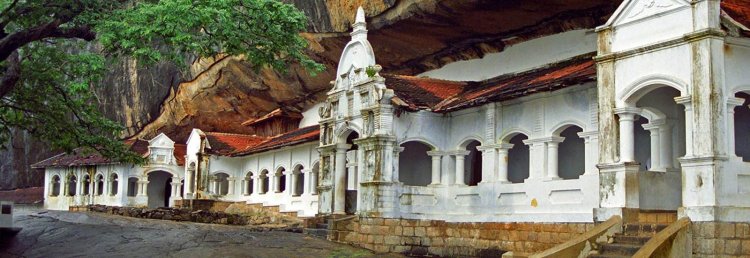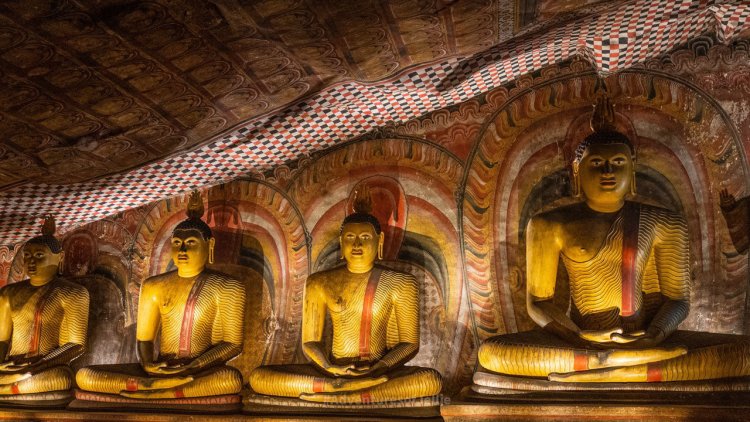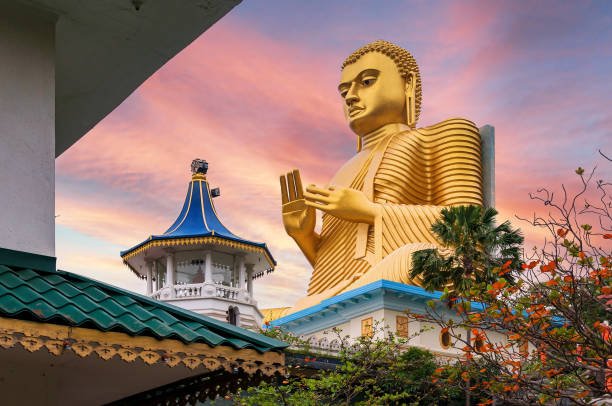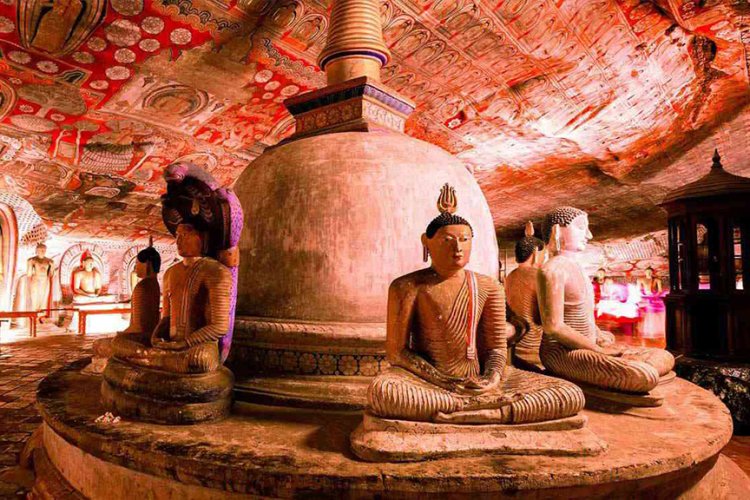Dambulla Royal Cave Temple and Golden Temple: Sri Lanka’s Hidden Spiritual Gem
Discover Dambulla Royal Cave Temple and Golden Temple, Sri Lanka’s offbeat spiritual gem! Explore ancient Buddhist caves and serene views. Plan your unique adventure at imsrilanka.com.

Introduction to Dambulla: A Sacred Offbeat Adventure
Tucked away in the heart of Sri Lanka’s Cultural Triangle, the Dambulla Royal Cave Temple and Golden Temple beckon travelers with a blend of ancient spirituality, artistic wonder, and serene beauty. Perched atop a rocky outcrop in the Matale District, this UNESCO World Heritage Site is a labyrinth of five sacred caves adorned with vibrant Buddhist murals and statues, dating back to the 1st century BC. Below, the gleaming Golden Temple adds a modern yet majestic touch, its towering golden Buddha statue visible for miles. Far from the crowded tourist trails, Dambulla offers an offbeat escape for those seeking a deeper connection with Sri Lanka’s cultural and spiritual heritage.
For international travelers, Dambulla is a hidden gem that combines history, art, and tranquility in an unforgettable setting. Whether you’re a culture enthusiast, a spiritual seeker, or an adventurer looking for unique destinations, the Dambulla Cave Temple and Golden Temple promise a journey into the soul of Sri Lanka. This guide explores why Dambulla stands out as an offbeat travel destination, what makes it a must-visit, and how to plan your visit for an enriching experience. From climbing ancient rock steps to marveling at centuries-old frescoes, here’s everything you need to know about exploring Dambulla.

Why Visit Dambulla Cave Temple and Golden Temple?
Dambulla’s allure lies in its unique blend of ancient history, sacred significance, and off-the-beaten-path charm. Unlike Sri Lanka’s more famous sites like Sigiriya or Kandy, Dambulla offers a quieter, more introspective experience, perfect for travelers craving authenticity. Here’s why Dambulla should be on your travel itinerary:
-
Ancient Art and History: The cave temples, dating back over 2,000 years, house intricate murals and over 150 Buddhist statues, showcasing Sri Lanka’s artistic legacy.
-
Spiritual Serenity: As a sacred pilgrimage site, Dambulla offers a peaceful setting for reflection and connection with Buddhist traditions.
-
Offbeat Appeal: Less crowded than other Cultural Triangle sites, Dambulla feels like a discovery, offering an intimate experience with its caves and surroundings.
-
Golden Temple Majesty: The modern Golden Temple at the base, with its iconic golden Buddha, adds a striking contrast to the ancient caves.
-
Scenic Beauty: The climb to the caves rewards visitors with panoramic views of lush jungles and distant hills, perfect for nature lovers.
For foreign visitors, Dambulla is a chance to step off the typical tourist path and immerse in a site that blends spirituality, history, and natural splendor, making it a perfect offbeat destination.

The History and Significance of Dambulla
The Dambulla Royal Cave Temple, also known as the Golden Temple of Dambulla, has been a sacred site for over 2,000 years. Legend has it that King Valagamba, exiled in the 1st century BC, took refuge in these caves and later transformed them into a Buddhist sanctuary to honor his return to power. Over centuries, successive kings embellished the caves with statues, paintings, and inscriptions, creating a masterpiece of religious art. The five caves, carved into a massive granite outcrop, house a collection of Buddha statues, deities, and vibrant frescoes that depict scenes from the Buddha’s life.
The Golden Temple, built in the 1990s at the base of the rock, adds a modern layer to Dambulla’s story. Its 30-meter golden Buddha statue, one of the largest in Sri Lanka, symbolizes the enduring relevance of Buddhism. The adjacent Buddhist Museum offers insights into the religion’s global influence. Together, the cave temples and Golden Temple form a UNESCO World Heritage Site, recognized in 1991 for their cultural and historical value.
For international travelers, Dambulla’s rich history and spiritual ambiance offer a window into Sri Lanka’s ancient Buddhist heritage, while its offbeat nature ensures a personal, uncrowded experience.
Exploring Dambulla: Top Experiences and Attractions
Dambulla is a treasure trove of experiences, from exploring ancient caves to soaking in scenic views. Here are the must-do activities for your visit:
1. Discovering the Cave Temples
The heart of Dambulla lies in its five cave temples, each a unique sanctuary of art and devotion. As you climb the 364 steps to the caves, the air cools, and the scent of incense wafts through the jungle. Inside, the caves are a marvel:
-
Cave I (Devaraja Lena): Home to a 14-meter reclining Buddha, carved from rock, exuding serene tranquility.
-
Cave II (Maharaja Lena): The largest cave, with over 60 statues and vivid frescoes depicting Buddhist tales, glowing under soft light.
-
Cave III (Maha Alut Viharaya): Adorned with 50 statues and a ceiling painted with intricate lotus motifs.
-
Cave IV (Pachima Viharaya): A smaller cave with a seated Buddha under a makara torana (dragon arch).
-
Cave V (Devana Alut Viharaya): Features a reclining Buddha and colorful murals from later periods.
The cool, dimly lit caves, filled with the hum of chanting monks, create a mystical atmosphere that feels like stepping back in time.

Travel Tip: Allow 1-2 hours to explore the caves, and bring a flashlight to appreciate the murals’ details. Photography is permitted without flash.
2. Marveling at the Golden Temple
At the base of the rock, the Golden Temple greets you with its gleaming 30-meter Buddha statue, perched atop a vibrant museum. The statue’s golden hue shimmers in the sunlight, while the temple’s kitschy yet charming dragon-mouth entrance adds a playful touch. Inside, the Buddhist Museum displays artifacts and exhibits on Buddhism’s global spread, offering context for the caves above.

Travel Tip: Visit the Golden Temple before climbing to the caves to gain historical context. Entry is free, but donations are appreciated.
3. Soaking in Panoramic Views
The climb to the cave temples, though steep, rewards you with breathtaking views of the surrounding countryside. From the rock’s summit, lush jungles stretch toward the horizon, with the distant Sigiriya Rock visible on clear days. The serene landscape, dotted with paddy fields and hills, is perfect for reflection or photography.
Travel Tip: Pause at the viewing platform near the caves for photos, especially at sunset when the sky glows orange.
4. Encountering Wildlife
The path to the caves is alive with playful toque macaques, scampering across rocks and trees. Their cheeky antics add a lively charm to the climb, though you’ll want to secure your belongings. Birdsong fills the air, with species like the Sri Lanka grey hornbill occasionally spotted.
Travel Tip: Keep food and shiny objects hidden to avoid monkey mischief, and bring binoculars for birdwatching.
5. Experiencing Local Culture
At the base, local vendors sell lotus flowers and incense for offerings, offering a glimpse into Sri Lankan devotional practices. Engage with monks or pilgrims to learn about the temple’s significance, or visit nearby villages to see traditional crafts like batik and wood carving.
Travel Tip: Offer a lotus flower at the caves for a small donation ($1-2 USD) to participate in a local ritual.

Planning Your Visit to Dambulla: Practical Tips for Foreign Travelers
To ensure a seamless and enriching visit to Dambulla, here are essential tips for international travelers:
Getting to Dambulla
Dambulla is 150 km from Colombo and 20 km from Sigiriya, making it an easy stop in the Cultural Triangle:
-
By Bus: Buses from Colombo to Dambulla take 3-4 hours ($2-5 USD). From Sigiriya, a local bus or tuk-tuk costs $1-3 USD (30 minutes).
-
By Train: Take a train to Habarana or Matale (3-4 hours, $2-6 USD), then a tuk-tuk to Dambulla ($5-10 USD).
-
By Private Car: A car with a driver from Colombo costs $50-80 USD, offering comfort and flexibility.
-
By Tuk-Tuk: From Kandy, a tuk-tuk ride costs $15-20 USD (1.5-2 hours).
Travel Tip: Use Dambulla as a base for exploring nearby sites like Sigiriya or Anuradhapura, and book transport via imsrilanka.com for convenience.
Best Time to Visit
The best time to visit is December to April, when the weather is dry and cool (25-30°C), ideal for climbing to the caves. February and March offer clear skies for panoramic views. The rainy season (May-October) brings lush greenery but slippery steps, so pack accordingly.
Travel Tip: Visit early morning (7-9 AM) to avoid crowds and heat, and check for Poya (full moon) days, when the temple is busier with pilgrims.

Tickets and Costs
-
Entrance Fee: The ticket for the cave temples is $10 USD for foreigners, payable at the ticket office near the Golden Temple.
-
Guides: Local guides cost $5-10 USD and provide valuable insights into the caves’ history and art.
-
Additional Costs: Budget $2-5 USD for snacks, water, or offerings at local stalls.
Travel Tip: Buy tickets at the official counter to avoid scams, and carry cash (Sri Lankan Rupees) for small purchases.
What to Bring
-
Lightweight, modest clothing (covering shoulders and knees) for temple visits
-
Comfortable shoes for the steep climb
-
A scarf or sarong for extra coverage
-
Sunscreen, a hat, and sunglasses for sun protection
-
A reusable water bottle and camera for scenic shots
Travel Tip: Wear socks to remove shoes easily at the caves, as bare feet are required inside.
Where to Stay
Dambulla offers accommodations for all budgets:
-
Budget: Dambulla City Hostel ($10-20 USD/night) for simple, central stays.
-
Mid-Range: Amaya Lake ($50-80 USD/night) for lakeside comfort.
-
Luxury: Heritance Kandalama ($100-150 USD/night) for eco-luxury with cave views.
Travel Tip: Book early during peak season (December-April) via imsrilanka.com for the best rates.
Exploring Nearby Offbeat Gems
Dambulla’s location in the Cultural Triangle makes it ideal for day trips:
-
Sigiriya Rock Fortress: 20 km away, this UNESCO site offers a dramatic climb and ancient frescoes, complementing Dambulla’s spiritual vibe.
-
Pidurangala Rock: A quieter alternative to Sigiriya, with stunning views and a cave temple, just 25 km away.
Travel Tip: Combine a morning visit to Dambulla with an afternoon trip to Sigiriya for a full Cultural Triangle experience ($5-10 USD by tuk-tuk).
Cultural Experiences: Connecting with Dambulla’s Soul
Immerse yourself in Dambulla’s local culture:
-
Local Cuisine: Savor rice and curry or kottu roti at Mango Mango restaurant, where spicy flavors burst with authenticity.
-
Markets: Shop for spices, gems, or batik at Dambulla’s daily market, a vibrant hub of local life.
-
Poya Day Rituals: Visit during a full moon to witness pilgrims offering flowers and lighting oil lamps, a deeply spiritual experience.
What's Your Reaction?

















